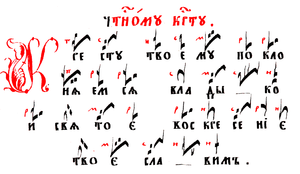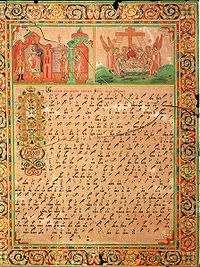
Znamennoe singing
Encyclopedia

Russia
Russia or , officially known as both Russia and the Russian Federation , is a country in northern Eurasia. It is a federal semi-presidential republic, comprising 83 federal subjects...
n Orthodox Church. Znamenny Chant is unison
Unison
In music, the word unison can be applied in more than one way. In general terms, it may refer to two notes sounding the same pitch, often but not always at the same time; or to the same musical voice being sounded by several voices or instruments together, either at the same pitch or at a distance...
, melismatic
Melisma
Melisma, in music, is the singing of a single syllable of text while moving between several different notes in succession. Music sung in this style is referred to as melismatic, as opposed to syllabic, where each syllable of text is matched to a single note.-History:Music of ancient cultures used...
liturgical
Liturgy
Liturgy is either the customary public worship done by a specific religious group, according to its particular traditions or a more precise term that distinguishes between those religious groups who believe their ritual requires the "people" to do the "work" of responding to the priest, and those...
singing that has its own specific notation, called the stolp notation. The symbols used in the stolp notation are called Kryuki (Russian: крюки) or Znamena (Russian: знамена). Often the names of the signs are used to refer to the stolp notation. Znamenny melodies are part of a system, consisting of Eight Modes (intonation structures; called hlasy); the melodies are characterized by fluency and well-balancedness. There exist several types of Znamenny Chant: the so-called Stolpovoy, Malyj (Little) and Bolshoy (Great) Znamenny Chant. The Ruthenian
Ruthenian
Ruthenian may refer to:*Ruthenia, a name applied to various parts of Eastern Europe*Ruthenians, a historic ethnic group*Ruthenian Catholic Church, the sui iuris particular church united to the Bishop of Rome and the Roman Catholic Church...
Chant (Prostopinije
Prostopinije
Prostopinije is a type of monodic church chant, closely related to Znamenny Chant. Prostopinije is used in the Ruthenian Catholic Church and among the Carpatho-Russian Orthodox....
) is sometimes considered a sub-division of the Znamenny Chant tradition, with the Muscovite
Grand Duchy of Moscow
The Grand Duchy of Moscow or Grand Principality of Moscow, also known in English simply as Muscovy , was a late medieval Rus' principality centered on Moscow, and the predecessor state of the early modern Tsardom of Russia....
Chant (Znamenny Chant proper) being the second branch of the same musical continuum.
Notation
Znamenny Chants are not written with notes (the so-called linear notation), but with special signs, called Znamëna (Russian for "marks", "banners") or Kryuki ("hooks"), as some shapes of these signs resemble hooks. Each sign may include the following components: a large black hook or a black stroke, several smaller black 'points' and 'commas' and lines near the hook or crossing the hook. Some signs may mean only one note, some 2 to 4 notes, and some a whole melody of more than 10 notes with a complicated rhythmic structure.
Kievan Rus'
Kievan Rus was a medieval polity in Eastern Europe, from the late 9th to the mid 13th century, when it disintegrated under the pressure of the Mongol invasion of 1237–1240....
as an East Slavic
East Slavs
The East Slavs are Slavic peoples speaking East Slavic languages. Formerly the main population of the medieval state of Kievan Rus, by the seventeenth century they evolved into the Russian, Ukrainian, and Belarusian peoples.-Sources:...
refinement of the Byzantine
Byzantine music
Byzantine music is the music of the Byzantine Empire composed to Greek texts as ceremonial, festival, or church music. Greek and foreign historians agree that the ecclesiastical tones and in general the whole system of Byzantine music is closely related to the ancient Greek system...
neumatic musical notation.
The most notable feature of this notation system is that it records transitions of the melody, rather than note
Note
In music, the term note has two primary meanings:#A sign used in musical notation to represent the relative duration and pitch of a sound;#A pitched sound itself....
s. The signs also represent a mood and a gradation of how this part of melody is to be sung (tempo, strength, devotion, meekness, etc.) Every sign has its own name and also features as a spiritual symbol. For example, there is a specific sign, called "little dove" (Russian: голубчик (golubchik)), which represents two rising sounds, but which is also a symbol of the Holy Ghost.
After the fall of Kievan Rus'
Kievan Rus'
Kievan Rus was a medieval polity in Eastern Europe, from the late 9th to the mid 13th century, when it disintegrated under the pressure of the Mongol invasion of 1237–1240....
to the mongols
Mongols
Mongols ) are a Central-East Asian ethnic group that lives mainly in the countries of Mongolia, China, and Russia. In China, ethnic Mongols can be found mainly in the central north region of China such as Inner Mongolia...
, the Znamenny Chant and stolp notation continued to develop to the North (particularly in Novgorod), where it flourished and was adopted throughout the Grand Duchy of Moscow
Grand Duchy of Moscow
The Grand Duchy of Moscow or Grand Principality of Moscow, also known in English simply as Muscovy , was a late medieval Rus' principality centered on Moscow, and the predecessor state of the early modern Tsardom of Russia....
.
Gradually the system became more and more complicated. This system was also ambiguous, so that almost no one, except the most trained and educated singers, could sing an unknown melody at sight. The signs only helped to reproduce the melody, not coding it in an unambiguous way.
Because of the complexity of the system, a simplification was developed by Ivan Shaidurov around 1600, called "red marks" (Russian: киноварные знаки (kinovarnye znaki)), which consisted of small letters in red and which were placed before each Znamenny sign. These indicate the highest note of the sign it stands before. This is generally regarded as the first step towards a certain simplification of the system.
The use and evolution of the system stopped in the middle of the 17th century, after the church reforms
Raskol
Raskol |schism]]') was the event of splitting of the Russian Orthodox Church into an official church and the Old Believers movement in mid-17th century, triggered by the reforms of Patriarch Nikon in 1653, aiming to establish uniformity between the Greek and Russian church practices.-The Raskol:...
by Patriarch Nikon
Patriarch Nikon
Nikon , born Nikita Minin , was the seventh patriarch of the Russian Orthodox Church...
. From that time Western music started to penetrate into Russian culture, and the Russian-Orthodox Church introduced a "Latin", polyphonic way of singing, based on Polish, German and Italian harmonies. The term "Latin" however was considered derogatory, since it also referred to "heretical Latin faith". The Znamenny Chant, however, has been preserved to a certain degree in the chanting traditions that are directly descended from it.
Current Usage and Related Traditions
Currently, the stolp notation (Znamenny signs) continues to be used by the Russian Old BelieversOld Believers
In the context of Russian Orthodox church history, the Old Believers separated after 1666 from the official Russian Orthodox Church as a protest against church reforms introduced by Patriarch Nikon between 1652–66...
, mostly in combination with the above-mentioned "red marks", as shown in the first illustration. In the 19th century Edinovertsy, particularly outside Russia, have tried to move to the modern neume
Neume
A neume is the basic element of Western and Eastern systems of musical notation prior to the invention of five-line staff notation. The word is a Middle English corruption of the ultimately Ancient Greek word for breath ....
form of notation that tries to capture exact relations between pitch
Pitch (music)
Pitch is an auditory perceptual property that allows the ordering of sounds on a frequency-related scale.Pitches are compared as "higher" and "lower" in the sense associated with musical melodies,...
es; and they currently use a standard linear notation
Musical notation
Music notation or musical notation is any system that represents aurally perceived music, through the use of written symbols.-History:...
.
Chanting traditions that preserve and/or are descended from the Znammeny Chant include:
- Chanting traditions of the Russian Old BelieversOld BelieversIn the context of Russian Orthodox church history, the Old Believers separated after 1666 from the official Russian Orthodox Church as a protest against church reforms introduced by Patriarch Nikon between 1652–66...
- Znamenny Chant proper (Знамя, Большое Знамя)
- Stolpovoy Chant
- Demesvenny Chant or Demestvo (Демество)
- Pomorsky Chant
- 'UkrainianUkrainian languageUkrainian is a language of the East Slavic subgroup of the Slavic languages. It is the official state language of Ukraine. Written Ukrainian uses a variant of the Cyrillic alphabet....
Chants'- The chanting tradition of Galicia (known as Samoilka chant)
- ProstopinijeProstopinijeProstopinije is a type of monodic church chant, closely related to Znamenny Chant. Prostopinije is used in the Ruthenian Catholic Church and among the Carpatho-Russian Orthodox....
(or Plain Chant) of the Carpatho-RusynsRusynsCarpatho-Rusyns are a primarily diasporic ethnic group who speak an Eastern Slavic language, or Ukrainian dialect, known as Rusyn. Carpatho-Rusyns descend from a minority of Ruthenians who did not adopt the use of the ethnonym "Ukrainian" in the early twentieth century...
- Valaam Chant
The Strochnoy chant (early Russian polyphony
Polyphony
In music, polyphony is a texture consisting of two or more independent melodic voices, as opposed to music with just one voice or music with one dominant melodic voice accompanied by chords ....
) was also based on the Znamenny chant, and although it is not widely used in the church practice now, it can be occasionally performed by some choirs. Some Russian composers (Alexander Gretchaninov
Alexander Gretchaninov
Alexander Tikhonovich Gretchaninov was a Russian Romantic composer.-His life:Gretchaninov started his musical studies rather late because his father, a businessman, had expected the boy to take over the family firm...
, Vladimir Martynov
Vladimir Martynov
Vladimir Martynov is a Russian composer, born on February 20, 1946 in Moscow, known for his music in the Concerto, Orchestral Music, Chamber Music and Choral Music genres....
) have studied Znamenny chant, and used it in their compositions. There are also many adaptations of the Znamenny melodies for the 4-parts choir that are popular in some Orthodox parishes in the USA.
Performing Practice
Because Znamenny Chant requires a specific manner of performance, the so-called Chant Books contain several instructions as to dynamics and tempo. For the Old Believers church chant also has an educational function: one has to sing in such a way that the sound astonishes the ear and the truth, enclosed in the chants, penetrates the heart. Znamenny performance practice excludes classical vocal training. Singers perform with their own, natural voices, sometimes in a style reminiscent of folklore. Znamenny Chant does not have any pauses or rests, and all chants are performed fluently. Ideally, singers will sing in such a way that their voices become united in one single voice.Originally Znamenny Chant was performed only by male voices. Today, due to a decay in the traditions and the small number of people able to sing at church services, it is usually performed by both by male and female voices.
External links
- Explanation and History of Znamenny Chant
- Traditional Eastern Orthodox Chant Documentation Project - a lot of information and notes. (English)
- Observations on the Early Russian Collections of the Library of Congress - references to Znamenny Chant (archived version of parent page is here)
- The History of Plain Chant

